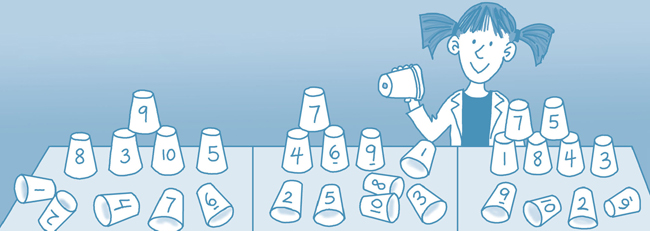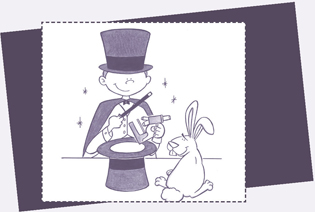Everything Kids' Magical Science Experiments Book (14 page)
Read Everything Kids' Magical Science Experiments Book Online
Authors: Tim Robinson
Tags: #epub, ebook


Chord:
A combination of three or more musical notes that make a pleasant sound.
Frequency:
A count of the number of waves produced by a certain sound each second.

- How accurately did your subjects' choices match the pairs that Pythagoras discovered?

- Can you predict combinations of three or more notes that you think would sound good together? In music, these combinations are known as chords.

- Notes on a piano are grouped into octaves. Do you think that if you chose a different octave, with its associated frequencies, the note pairings that sound nice together would stay the same? Why or why not?

Demo version limitation
Demo version limitation
Wind and Weather

E
ach night on the news, a meteorologist presents the day's weather and gives predictions for the next day. In that report, viewers often hear about high and low temperatures, winds, and any rain or snow that may have fallen. You may hear people talk about temperatures, wind speeds, and rain, but do they really know what weather is all about? This isn't a book about weather, but in this chapter, you will explore air and how it behaves in all kinds of situations. You will create an air cannon, seal a leaking balloon, make cereal float, and create an imploding time bomb.
Some people hear the word
cannon
and automatically think about something violent, used in times of war or for celebrating a score at an athletic event. But this cannon is perfectly safe and can actually help you impress your friends while performing some amazing feats.
Question: How can you blow out a candle from across the room?
The original air cannon was called the Air Blaster, made by the Wham-O toy company. It was introduced in 1965, and you can learn more about Wham-O at their Web site. Follow the “About Us” link to read about the company's long history of innovative toys:
www.wham-o.com.
- Clean 8-ounce yogurt container
- Adult helper
- Scissors or knife
- Medium balloon
- Rubber band
- Lit candle
- Ask your adult helper to cut a small hole in the bottom of the yogurt container. The hole should be approximately one-half inch in diameter.
- Cut the mouth off the balloon and stretch it across the top opening of the yogurt container. Secure the balloon to the mouth of the container with the rubber band.
- Tap on the balloon to produce a small burst of air out the hole in the bottom of the container.
- Bring your air cannon near the candle and tap on the balloon until you can make the candle go out.
When you tap on the balloon, you compress all the air in the container. As the volume of the air decreases, the pressure inside the container increases. All that air has to go somewhere, so it gets pushed out the hole in the bottom. As the air passes through the small hole, it picks up speed. The air comes out of the hole as a vortex, and it tends to keep its form and can travel surprising distances across a room.
See how far you can move from the candle and still blow it out using your air cannon. Some cannons have been known to work from across an entire room. You can also set up paper cups on a table as targets and practice knocking them over. Be careful when using your air cannon around people or pets, however. An unexpected blast of air is not always a welcome surprise. Several versions of this air cannon are possible, including one you can purchase at many toy stores. But you can experiment with building larger versions yourself. You can try using a tin can, such as one that would hold soup, vegetables, or dog food. Or you could use a larger can, such as one that would hold canned tomatoes. If you really want to upgrade your air cannon, try making one out of a plastic bucket or garbage can. You will need to experiment with various materials in place of the balloon, but the larger you make your cannon, the farther its bursts of air will travel.

This young scientist used an air cannon to knock over three towers of paper cups. With which tower did she get the highest score? Count only the paper cups that have fallen on the table.
Extra Fun: If the scientist tries again, and knocks over two more cups in each tower, what is the highest score she can get?
Cereal is a common breakfast food, one that is quick and easy, and also can be very nutritious. But chances are you didn't know it also can serve as a magical science experiment. Because of a relationship discovered by Daniel Bernoulli, air has the ability not only to lift up a piece of your favorite cereal, but keep it floating off the table as long as you can provide the air.
Question: Does cereal float?
- Spherical pieces of your favorite cereal
- Drinking straw that bends near the top
- Bend the upper part of the straw so it makes an L-shape.
- Place your mouth at the long end of the straw with the bent end pointing up into the air.
- While you blow through the straw, place one piece of cereal just above the far end, where the air is exiting the straw.
- Try to balance the piece of cereal above your straw while you blow through it. With practice you should be able to control the height at which the cereal floats above the straw.
Daniel Bernoulli discovered that in a stream of moving air, the pressure is lower than in the air outside the stream that is not moving. While the piece of cereal is in the stream of air, it stays in a position of lower air pressure. As it drifts toward the edge of the moving air stream, it hits the air with higher pressure and is pushed back into the stream. As long as the air stream remains, the cereal will stay “stuck” in the stream and will float.

BERNOULLI PRINCIPLE:
When a substance, including air, speeds up, the pressure decreases.
You can explore this idea on a larger scale by setting a hair dryer on a table so that it points upward. Turn it on and place a Ping Pong ball in the air stream above the hair dryer. It should float. The Bernoulli Principle doesn't just make small objects fly, however. It is one factor that helps airplanes fly. If you research the shape of an airplane's wings, you'll see that they are designed so that air travels faster over the top of the wings than below. This creates an area of lower pressure above the wing, which helps the airplane stay in the air. Can you find other places this principle shows up? It might surprise you to see just how common it is.
KIDS' LAB LESSONS

This experiment explores the fact that air takes up space. You may not be able to see it, but it's there and this experiment will demonstrate that. The goal will be to blow up a balloon inside a plastic bottle. But in the first version of this experiment, you will first attempt to inflate the balloon without placing anything else inside the bottle. You will then add a straw to see if it has any effect on your ability to blow up the balloon. In the second version, the bottle will first be untouched and then will have a small hole placed in it. Your task will be to determine whether that hole has any effect on your ability to inflate the balloon.
Air takes up space. You actually demonstrate this every time you take a breath. As you breathe in, your lungs expand to hold the air. When you breathe out that air, your chest and lungs deflate a little bit. In this case, you are dealing with air that already resides inside the bottle. When you try to put air into the balloon, it has to displace the air already in the bottle. With no exit path availableâthis happens in the first test when nothing is added to the bottle, and in the second when no hole is present in the bottleâthe existing air stays right where it is and it becomes impossible for the balloon to inflate. However, by adding the straw, the air now has a path to travel and it can escape. This makes room for the new air you are breathing into the balloon and it easily inflates. With a hole in the bottom of the bottle, the air inside the bottle just escapes out the hole and this is what allows the balloon to inflate.
- 2 (20-ounce or 1-liter) plastic bottles
- Drinking straw
- Thumbtack
- Medium balloon
Part I
- Place the balloon inside the bottle with its mouth sticking out the top of the bottle.
- Blow into the mouth of the balloon and try to inflate it. You should find it very difficult to do.
- Now place the straw next to the balloon inside the bottle. Be sure that the end of the straw sticks out of the mouth of the bottle.
- Try inflating the balloon again. You should find it much easier to do so.
Part II
- As before, place the balloon inside the bottle with its mouth sticking out the top of the bottle.
- Blow into the mouth of the balloon and try to inflate it. You should find it very difficult to do.
- Using the thumbtack, poke a small hole, about the size of a nail hole, in the bottom of the bottle.
- Now when you try to inflate the balloon by blowing into its mouth, it should inflate easily.
- Why did the balloon not inflate initially in either of the tests?

- Where did the air you blew into the balloons go in both tests?

- The straw and the hole you made in the bottle allowed air to escape from the bottle. Where did this air come from?

- If you are blowing air into the balloon and air is escaping through the straw or hole, how does the balloon inflate?

